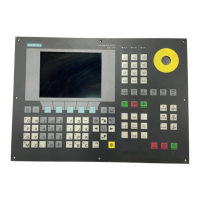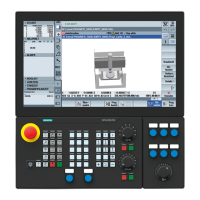W1: Tool offset
18.6 Toolholder with orientation capability
Basic Functions
1518 Function Manual, 09/2011, 6FC5397-0BP40-2BA0
Toolholder from G code of group 53
The G codes of group 53 (TOFRAME, TOROT, etc.) can be used to define a frame such that an axis direction (Z, Y
or X) in this frame is equal to the current tool orientation.
The G code of group 6 (G17 - G19), which is active at the time TOFRAME is called, determines the tool orientation.
If no toolholder is active, or if a toolholder is active but does not cause the tool orientation to change, the Z
direction in the new frame is:
• The same as the old Z direction with G17
• The same as the old Y direction with G18
• The same as the old X direction with G19.
These directions are modified accordingly for rotating toolholders. The same applies to the new X and Y
directions.
Instead of TOFRAME or TOROT, one of the G codes TOFRAMEX, TOFRAMEY, TOROTX, or TOROTY can be used.
The meanings of the axes are interchanged accordingly.
Group change
Changing the G code from group 42 (TCOABS, TCOFR, etc.) causes recalculation of the tool length components.
The (programmed) angles of rotation stored in the toolholder data are not affected, with the result that the angles
originally stored in the toolholder data are reactivated on a change from TCOFR to TCOABS.
Read rotary angle (α
1
or α
2
):
The angles currently used to calculate the orientation can be read via system variable $P_TCANG[n] where n = 1
or n = 2.
If two permissible solutions (i.e. a second valid pair of angles) are available for a particular orientation, the values
can be accessed with $P_TCANG[3] or $P_TCANG[4]. The number of valid solutions 0 to 2 can be read with
$P_TCSOL.
Tool radius compensation with CUT2D or CUT3DFS:
The current tool orientation is included in the tool radius compensation if either CUT2D or CUT3DFS is active in G-
code group 22 (tool compensation type).
For nonrotating toolholders, the behavior depends solely on the active plane of G code group 6 (G17 - G19) and
is, therefore, identical to the previous behavior.
All other tool compensation types:
The behavior for all other tool compensation types is unchanged.
For CUT2DF and CUT3DFF in particular, the compensation plane used for TRC is determined from the active
frame, independent of the current tool orientation. Allowance is made for the active plane (G17 - G19) and the
behavior is, therefore, the same as before.
The two remaining G codes of group 22, CUT3DC and CUT3DF, are not affected by the toolholder functionality
because the tool orientation information in these cases is made available by the active kinematic transformation.

